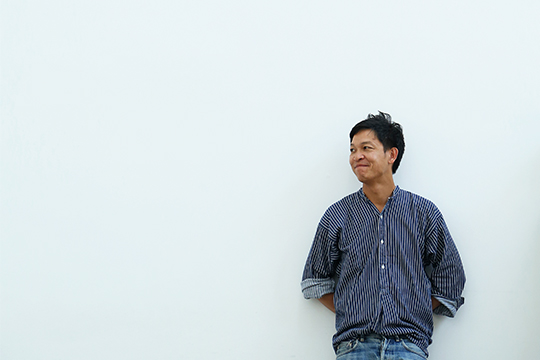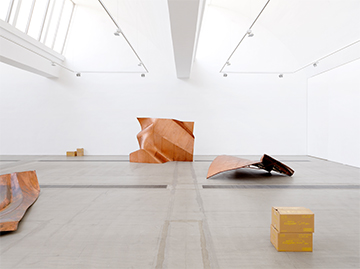Danh Vo
| July 9, 2014 | Post In LEAP 27

Danish artist Danh Vo is currently presenting his first solo exhibition in China, “Danh Vo: We the People,” at Faurschou Foundation in Beijing. On this occasion, LEAP conducted an exclusive interview with the artist that resulted in an in-depth dialogue revolving around Vo’s working methods, the relationship between his personal identity and his practice, the attitudes underlying his work, and other issues. Behind the hype surrounding this young artist, it became apparent, is a scrupulous and independent creative mind.
LEAP We The People contains themes of democracy, freedom, immigration, identity, and so forth—themes that resonate deeply with Western audiences. Yet these issues might have very difficult implications in the Chinese context. Did you consider this when bringing the work to China?
DANH VO Most of the exhibitions I’ve been doing amount to a sort of learning process. It’s not like a statement. It’s not like I make work and think, “OK, this means something for these people.” This is especially true of exhibiting We the People—it’s a process that I have to experience. That’s also why it was interesting for me to exhibit here, because I don’t think China is the most extreme example. For me it has been a tremendous experience, seeing these facets of projections: in the end, it’s not only about what we can achieve with the term “freedom,” but also with art.
Also, in many situations, the places drove the piece as well—a kind of reversal. At a certain point, the perception of what you do is confined. People will make their own projections, saying “Oh, this is what the artist is doing.” My reaction is, “OK, I want to do something that’s at the other end of this game.” It was in a way conceptual, because I wanted to see where the project would lead, what it would bring me. This is the only way to do such a project.
LEAP The materials in your work—thin copper sheeting or cardboard, and so on—seem to be not only metaphors of solid conviction and its fragile reality, but also to refer to some kind of melancholic trauma. What is the position of material in your creation? Does it approach an animist perspective?
DV To be honest? Yes. First of , with We the People, I didn’t even know there was copper; I didn’t even know what copper was. When I started, I had to learn what copper means, and how it’s different from bronze. This is why I always refer to the work as conceptual: it’s about an idea that you follow. What is amazing is that I didn’t see many of the pieces until they arrived at the space. When I stood in front of them for the first time, I felt totally estranged. In a way, I was lucky: what was interesting for me could have turned out really badly.
Before, I had never been to the Statue of Liberty at all. When I did go, I discovered it is actually not that big, that the surface was only two millimeters thick. That discovery creates possibilities. Because it’s not what you thought it was. It’s actually something else. As for the technique of making the copper—how they did it was just beautiful. It was like hammering out the image of a deity.
LEAP Your personal experiences seem rather legendary. Do you think the connection between individual life and creation may lead your work to depend largely on “chance”?
DV To approach the question from a slightly different perspective: the artist’s inner thoughts are personal, but because we see them as a public issue they become less invisible. There should be a clearer delineation between what is private and what is public. Like as a gay person, if I kiss a guy on the street, most people would say I am bringing the private into the public. But if a man and a woman kiss on the street, we don’t even notice. I don’t think we should follow those rules, because those rules are not ours.
When I started We the People, it wasn’t about making a shift in scale; I was so tired of people referring to my work as personal that it occurred to me to take an icon that everybody has an image and idea of, and twist it a little bit. People will still talk about the inclusion of “blah blah blah,” but I really don’t care. Because it’s out of my control, it’s not my problem.

Beijing Faurschou Foundation.
PHOTO: Jonathan Leijonhufvud
Courtesy of Faurschou Foundation
LEAP Contemporary art is a field where people inevitably pay a lot of attention to your identity. As your works often refer to the question of cultural or ideological identity, do you think your identity is a part of your work?
DV Identity is something you always have to accept. I would even say that I take it to another level: if I cannot get rid of it, then I can abuse it. Abusing my identity is to make sense of my identity, because it doesn’t make sense anymore anyway. For me, what is beautiful with art is that things don’t necessarily make sense. But the big picture, of how art works and how the art world functions, problematizes people’s efforts to tie everything together.
LEAP Many Western critics have been keen to mention that We The People was produced in Shanghai, a fact which of course adds another layer of interpretation. But you deny the necessity of this particular interpretation.
DV If I could erase that aspect of the work, I would do it anytime. But it’s just not possible. It was a Swiss company that took on the project and collaborated with Chinese. In Europe, the relevant technologies and methods of building sculpture is a thing of the nineteenth century—today, European companies are doing mostly restoration. But in China, you still build Buddhist sculptures.
I always felt that there have been enough interpretations of concepts like freedom. In the case of this project, I didn’t need to put my own voice in there. I never wanted to. Overall, the project was more about how we can activate a discussion. But the expectations are still that I make statements about freedom. This pressure activates a need to question things instead of claiming them, a tendency you see in most of my work. Since I started the project three years ago, I have approached it as if it were water, because if you do something that big, you also have to do it in reverse. Otherwise, you fall into the trap of making monuments.
LEAP We often talk about the transformation you have made, that of the Statue of Liberty to “abstract sculpture.” The more fragmented the pieces, the more life they have—perhaps the act of cutting and reshaping them contributes to this. Is there a performative aspect in your sculpture?
DV Absolutely. This is rooted in the idea that there is movement between things; they aren’t just black and white. I think this is probably the biggest achievement of the piece, and also why I talk about conceptual ideas. Let us consider the passport: it’s this one document that prevents so many millions of people from moving about freely. Performance is equal to a passport, and allows for this beautiful idea of reversing things. (Transcribed by Emily Feng)


